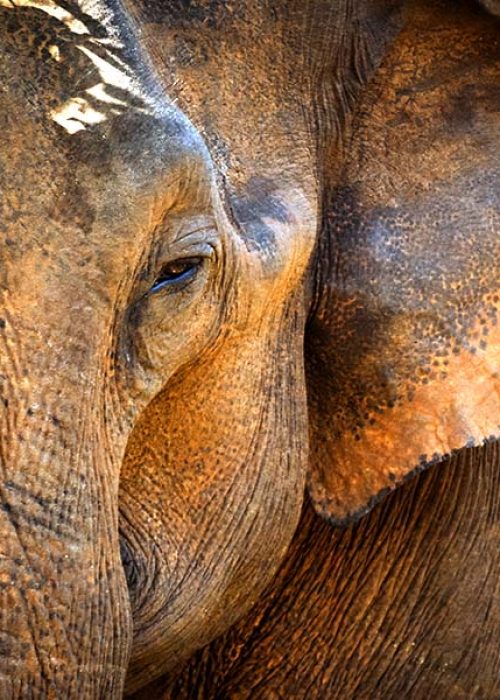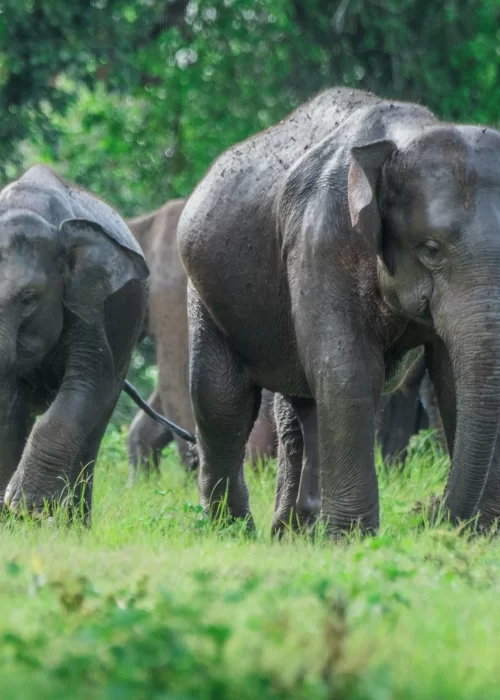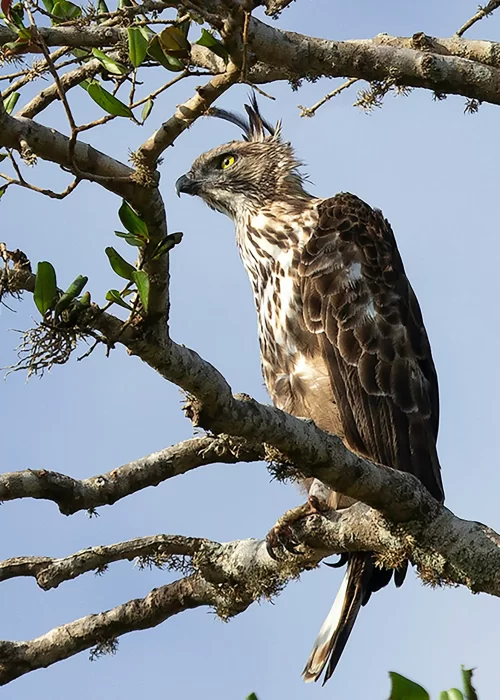Wildlife Adventures
Your Sri Lanka WildLife Adventures
Embark on an incredible journey through Wildlife Adventures Sri Lanka with Ceylon Habitat Explorer Tours. Our expert guides, fluent in English and more, lead you to hidden gems and must-see spots. Choose a private car for couples or a spacious van for groups. Our friendly guides share intriguing insights into Sri Lankan culture. Experience a thrilling safari in a 4×4 jeep, spotting elephants, leopards, and more in their natural habitat. Prices vary depending on location and duration, but we offer competitive rates. Our experienced safari drivers and guides know the terrain and wildlife well, ensuring a smooth and exciting journey. We handle everything, so you can focus on making unforgettable memories in Sri Lanka’s wildlife paradise!
Yala National Park

Yala National Park, placed inside the southeast of Sri Lanka, is a haven for nature enthusiasts and journey seekers. It boasts numerous flora and fauna and breathtaking landscapes, presenting an intimate enjoy with Sri Lanka’s herbal beauty. Visitors can explore its wealthy ecosystems and catch glimpses of wonderful animals of their herbal habitat.
Geography and Climate
Yala National Park spans around 979 square kilometers and is divided into five blocks, with Block 1 being the maximum popular and frequently visited. Situated in a semi-arid vicinity, the park is at its first-class from February to June while the climate is dry, making it simpler to spot the natural world. Its numerous panorama includes grasslands, forests, marshes, and exquisite sandy beaches alongside the coast, creating precise habitats for the animals that live there.
Get geared up to embark on a dawn safari at Yala National Park, wherein the nice and cozy tropical climate gives a median temperature of around 27°C (80°F). The park reviews a dry season from February to September and a wet season from October to January, with the dry season being the prime time to go to when you consider that animals accumulate around water resources.
A Wildlife Wonderland
Yala National Park is renowned for its abundance of flora and fauna, together with forty four species of mammals along with elephants, leopards, sloth bears, noticed deer, and wild boar. The park boasts one of the international’s maximum leopard densities, making it a awesome spot for glimpsing these elusive huge cats. Keep an eye fixed out for other animals like golden jackals, sambar deer, mongoose, and the endangered Sri Lankan elephant.
Yala is likewise home to 47 reptile species, consisting of crocodiles, snakes, and turtles, adding to the rich biodiversity of the park.
Safari Adventures at Yala
Embarking on a safari in Yala is a must-do activity. Choose from an early morning or late afternoon safari, as leopards are most active during these times. Booking a safari with an experienced guide enhances your chances of spotting these majestic creatures and other wildlife. While sightings aren’t guaranteed, Yala offers some of the best opportunities in the world.
Elephant safaris are another highlight, providing visitors the chance to observe these gentle giants in their natural habitat. The park’s elephant population is estimated at around 350-400 individuals, making for an unforgettable experience.
Birdwatching
Bird lovers will be thrilled with Yala National Park’s avian population, featuring over 215 bird species. Keep your eyes peeled for the Malabar pied hornbill, greater flamingo, and black-necked stork. The park also provides bird-watching hides for a closer look at its feathered residents. The best time for birdwatching is during the migratory season, which runs from November to March.
Best Time to Visit
Plan your visit Wildlife Adventures Sri Lanka during the dry season, from February to September, for the best chance of spotting wildlife. The park operates from 6 am to 6 pm daily but may close for about two weeks in September for maintenance. During the wet season, some areas might become inaccessible due to flooding, which can make wildlife spotting challenging.
Visitor Tips
- Yala National Park is closed on Mondays and Poya (full moon) days, so plan your trip accordingly.
- Dress modestly and avoid bright colors. Neutral, earthy tones blend in with the environment and help minimize disturbances to the wildlife.
- Be prepared for warm temperatures during the day by bringing sunscreen, a hat, and plenty of water.
- Ensure you have a valid permit to enter the park, which can be obtained at the entrance or through a tour operator.
- Bring your camera to capture Yala’s breathtaking wildlife scenes, but always maintain a safe distance from the animals and never attempt to feed or touch them.
- Respect the park’s rules and regulations, and always follow your guide’s instructions.
Udawalawa National Park

Located in the southeastern region of Sri Lanka, Udawalawe National Park is a haven for wildlife enthusiasts and adventure seekers. Known for its thriving elephant population and breathtaking landscapes, the park offers an up-close encounter with Sri Lanka’s natural wonders.
Geography & Climate
Udawalawe National Park spans around 308 square kilometers, featuring diverse habitats such as grasslands, forests, and wetlands. These varied landscapes support a rich array of wildlife. The park’s climate is tropical, with an average temperature of around 27°C (80°F). The best time to visit is during the dry season from January to September when wildlife is easier to spot.
Wild Life
Udawalawe is famous for its large elephant herds, making it an excellent place for an elephant safari. You can watch these gentle giants roam freely in their natural habitat—an unforgettable experience! The park is also home to other animals like water buffalo, crocodiles, and various species of deer.
Bird lovers will be delighted by the park’s avian population, boasting around 183 bird species. Keep your eyes peeled for species such as the changeable hawk-eagle, Sri Lankan junglefowl, and the rare Sri Lanka grey hornbill.
Safari Adveture at Udawalawa
Embark on a morning or late afternoon Wildlife Adventures Sri Lanka safari to see the park’s wildlife at its best. With the help of an experienced guide, you can observe elephants and other animals in their natural habitats. Whether you’re a seasoned wildlife enthusiast or a casual visitor, Udawalawe’s safaris offer something for everyone.
Visitor Tips
- Plan ahead: Udawalawe National Park is open daily from 6 am to 6 pm, but it may close occasionally for maintenance.
- Dress appropriately: Wear comfortable clothing in neutral colors to blend in with the surroundings and respect the wildlife.
- Bring essentials: Don’t forget sunscreen, a hat, and plenty of water to stay hydrated during your visit.
- Follow the rules: Always follow the park’s rules and your guide’s instructions to ensure a safe and respectful experience.
Wilpattu National Park

Sri Lanka’s northwest has a hidden treasure for animal lovers who like things calm – Wilpattu Park! Skip the busy tourist areas and explore peaceful lakes, called “willus,” instead. See amazing animals and enjoy Sri Lanka’s beauty in a relaxed way.
Geography and Climate
Wilpattu National Park spans around 1,317 square kilometers, making it the largest national park in Sri Lanka. The park’s unique feature is its network of over 40 natural lakes, providing a perfect habitat for a variety of wildlife. The park’s landscape includes dry lowland forests, grassy plains, and coastal areas, all contributing to its rich biodiversity.
The climate in Wilpattu is tropical and generally warm, with an average temperature of around 27°C (80°F). The park experiences two main seasons: the dry season from February to October and the wet season from November to January. The dry season is the prime time to visit, as wildlife gathers around the lakes, making it easier to spot them.
A Wildlife Wonderland
Wilpattu National Park is home to a wide variety of wildlife, including 31 species of mammals such as elephants, leopards, sloth bears, and spotted deer. The park boasts one of the world’s highest densities of leopards, making it a great spot for glimpsing these elusive big cats. Keep an eye out for other animals like water buffalo, sambar deer, and the endangered Sri Lankan elephant.
The park is also home to various species of reptiles, including crocodiles and turtles, as well as an array of colorful butterflies.
Safari Adventures and Bird Watching at Wilpattu
Embarking on a safari in Wilpattu is a must-do activity. Early morning or late afternoon safaris offer the best chances of spotting wildlife, especially leopards and elephants. Booking a safari with an experienced guide enhances your chances of seeing these majestic creatures and other animals in their natural habitats. Wilpattu National Park is a paradise for bird lovers, with over 200 bird species recorded in the park. Keep your eyes peeled for species such as the Ceylon junglefowl, painted stork, and the Malabar pied hornbill. The best time for birdwatching is during the migratory season, which runs from November to March.
Best Time to Visit & Visitor Tips
The best time to visit Wildlife Adventures Sri Lanka Wilpattu National Park is during the dry season from February to October when wildlife is more active around the lakes. The park is open daily from 6 am to 6 pm but may close occasionally for maintenance.
- Plan your visit ahead of time and ensure you have a valid permit, which you can obtain at the park entrance or through a tour operator.
- Wear comfortable clothing in neutral colors to blend in with the environment and minimize disturbances to the wildlife.
- Bring essentials like sunscreen, a hat, and plenty of water to stay hydrated during your visit.
- Respect the park’s rules and regulations, and follow your guide’s instructions.
- Bring your camera to capture Wilpattu’s stunning landscapes and wildlife scenes, but always maintain a safe distance from the animals.
Minneriya National Park

Situated in the central region of Sri Lanka, Minneriya National Park is a dream come true for wildlife enthusiasts. Known for its rich biodiversity and lush landscapes, this park provides visitors with the chance to experience the wonders of Sri Lanka’s nature up close.
The Geography and Climate
Minneriya National Park covers an area of around 88 square kilometers and centers around the scenic Minneriya Tank, a historic reservoir that dates back to ancient times. The park’s landscape is a blend of evergreen forests, grasslands, and wetlands, providing a perfect habitat for a variety of wildlife.
The climate in Minneriya is tropical, with temperatures averaging around 27°C (80°F). The best time to visit the park is during the dry season from May to October when wildlife gathers around the tank in search of water, making it easier to spot them.
A Wildlife Wonderland
Minneriya National Park is renowned for its large elephant gatherings, known as “The Gathering.” During the dry season, hundreds of elephants come to the Minneriya Tank, creating one of the most spectacular wildlife experiences in the world. You can also spot other animals like leopards, sambar deer, and sloth bears.
The park is home to various bird species, including the Sri Lanka junglefowl, painted stork, and the Malabar pied hornbill, making it a haven for birdwatchers.
Safari Adventures & Bird Watching at Minneriya
Embarking on a safari in Minneriya is a must-do activity. Early morning and late afternoon safaris offer the best opportunities to witness the majestic elephant gatherings and observe other wildlife in their natural habitats. An experienced guide can enhance your experience by pointing out different species and sharing interesting facts.
Minneriya National Park is a birdwatcher’s paradise, with over 160 bird species recorded in the park. Keep your eyes peeled for birds such as the Sri Lanka green pigeon, grey-headed fish eagle, and the endemic Sri Lanka spurfowl. The best time for birdwatching is during the migratory season, which occurs from November to March.
Best Time to Visit & Visitor Tips
Plan Wildlife Adventures Sri Lanka your visit during the dry season from May to October for the best chance of spotting wildlife, particularly during the incredible elephant gatherings. The park operates from 6 am to 6 pm daily.
Visitor Tips
- Plan ahead: Make sure to get a valid permit for entry, which you can obtain at the park entrance or through a tour operator.
- Dress appropriately: Wear comfortable clothing in neutral tones to blend in with the environment and minimize disturbances to the wildlife.
- Be prepared: Bring essentials like sunscreen, a hat, and plenty of water to stay hydrated during your visit.
- Follow the rules: Adhere to the park’s rules and your guide’s instructions for a safe and respectful experience.
- Capture the moments: Bring your camera to document Minneriya’s breathtaking wildlife scenes, but always maintain a safe distance from the animals.
Wasgamuwa National Park

Tucked away in the central region of Sri Lanka, Wasgamuwa National Park is a hidden gem for nature lovers and adventure seekers alike. Known for its diverse wildlife and scenic landscapes, Wasgamuwa offers visitors the chance to experience the natural beauty of Sri Lanka up close.
The Geography and Climate
Wasgamuwa National Park spans around 393 square kilometers and is characterized by its mix of evergreen forests, scrublands, and open grasslands. The Mahaweli and Amban Rivers border the park, creating a rich and varied ecosystem that supports an array of wildlife.
The climate in Wasgamuwa is typically tropical, with an average temperature of around 27°C (80°F). The park experiences a dry season from May to September, making it easier to spot wildlife as they gather around water sources. The rainy season occurs from October to January.
A Wildlife Wonderland
Wasgamuwa National Park is home to a wide variety of wildlife, including elephants, leopards, sloth bears, water buffalo, and sambar deer. Elephants are a major draw for visitors, often seen bathing and foraging in groups within the park.
The park also hosts many species of reptiles, including crocodiles and turtles, adding to its rich biodiversity.
Safari Adventures & Bird Watching at Wasgamuwa
A safari in Wasgamuwa is a must-do activity for any visitor. Early morning and late afternoon safaris offer the best chances of spotting wildlife in their natural habitats. Booking a safari with an experienced guide can enhance your experience by pointing out different species and sharing interesting insights.
Wasgamuwa National Park is a birdwatcher’s dream, with around 143 bird species recorded in the park. Keep an eye out for species such as the Sri Lanka junglefowl, painted stork, and Malabar pied hornbill. The best time for birdwatching is during the migratory season from November to March.
Best Time to Visit & Visitor Tips
Plan your Wildlife Adventures Sri Lanka visit during the dry season from May to September for the best chances of spotting wildlife. The park is open from 6 am to 6 pm daily but may close occasionally for maintenance.
- Plan ahead: Obtain a valid permit to enter the park from the entrance or through a tour operator.
- Dress appropriately: Wear comfortable, neutral-colored clothing to blend in with the environment and minimize disturbances to the wildlife.
- Be prepared: Bring essentials like sunscreen, a hat, and plenty of water to stay hydrated during your visit.
- Follow the rules: Always adhere to the park’s rules and your guide’s instructions for a safe and respectful experience.
- Capture the moments: Bring your camera to document Wasgamuwa’s stunning landscapes and wildlife scenes, but always maintain a safe distance from the animals.
Kawudulla National Park

Located in the central region of Sri Lanka, Kaudulla National Park is a treasure trove for wildlife enthusiasts and nature lovers. Known for its spectacular elephant gatherings and lush landscapes, this park offers an up-close and personal experience with the wonders of Sri Lanka’s nature.
The Geography and Climate
Kaudulla National Park spans around 66 square kilometers and is centered around the scenic Kaudulla Tank, a historic reservoir dating back to ancient times. The park’s diverse landscape includes evergreen forests, scrublands, and grasslands, providing a welcoming habitat for a variety of wildlife.
The climate in Kaudulla is tropical, with an average temperature of around 27°C (80°F). The best time to visit the park is during the dry season from May to October when wildlife, particularly elephants, gathers around the tank, creating breathtaking spectacles.
A Wildlife Wonderland
Kaudulla National Park is renowned for its large herds of elephants, which often migrate between the park and nearby Minneriya National Park. Witnessing these majestic creatures up close, whether bathing or foraging, is a truly unforgettable experience.
In addition to elephants, the park is home to other animals such as leopards, sambar deer, and water buffalo. It also supports a variety of bird species, making it a birdwatcher’s paradise.
Safari Adventures at Kaudulla
A safari in Kaudulla is a must-do activity for any visitor. Early morning and late afternoon safaris offer the best opportunities to see wildlife, especially during the elephant gatherings. Booking a safari with an experienced guide can help enhance your chances of spotting different species and learning about their natural habitats.
Kaudulla National Park is a treat for birdwatchers, with numerous bird species recorded in the park. Look out for birds such as the Sri Lanka junglefowl, grey-headed fish eagle, and the Malabar pied hornbill. The migratory season from November to March is the prime time for birdwatching.
Best Time to Visit & Visitor Tips
Plan your Wildlife Adventures Sri Lanka visit during the dry season from May to October for the best chance of spotting wildlife, particularly the elephants. The park operates from 6 am to 6 pm daily.
- Plan ahead: Make sure to get a valid permit for entry, which you can obtain at the park entrance or through a tour operator.
- Dress appropriately: Wear comfortable, neutral-colored clothing to blend in with the environment and avoid disturbing the wildlife.
- Be prepared: Bring essentials like sunscreen, a hat, and plenty of water to stay hydrated during your visit.
- Follow the rules: Adhere to the park’s rules and your guide’s instructions for a safe and respectful experience.
- Capture the moments: Bring your camera to document Kaudulla’s stunning landscapes and wildlife scenes, but always maintain a safe distance from the animals.
